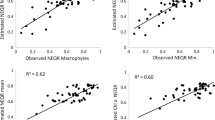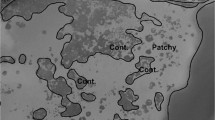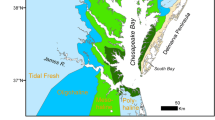Abstract
This work supports previous studies in the Great Barrier Reef lagoon that show the new nitrogen (N) load introduced by Trichodesmium is similar to or greater than that from riverine discharges. However, the current management programs aimed at improving the chronic eutrophic state of the GBR ignore the N load from Trichodesmium. These programs also ignore the evidence that Trichodesmium blooms could promote the bioavailability of heavy metals and be a source of toxins in the ciguatera food chain. Further work is urgently required to better quantify the potential impacts of Trichodesmium and develop management plans to reduce those impacts. A simple algorithm that uses MODIS imagery is developed for not only monitoring the spatial extent of Trichodesmium blooms but also for quantifying the concentration of those blooms. The algorithm is based on the readily available MODIS L2 data. A management plan that includes the harvesting of Trichodesmium is outlined.






Similar content being viewed by others
References
Bartley, R., D. Waters, R. Turner, F. Kroon, S. Wilkinson, A. Garzon-Garcia, P. Kuhnert, S. Lewis, et al. 2017. Scientific Consensus Statement 2017: A synthesis of the science of land-based water quality impacts on the Great Barrier Reef, Chapter 2: Sources of sediment, nutrients, pesticides and other pollutants to the Great Barrier Reef. State of Queensland, 2017.
Bell, P.R.F. 1992. Eutrophication and coral reefs-some examples in the Great Barrier Reef lagoon. Water Research 26: 553–568.
Bell, P.R.F., and I. Elmetri. 1995. Ecological Indicators of Large Scale Eutrophication in the Great Barrier Reef (GBR) Lagoon. Ambio 24: 208–215.
Bell, P.R.F., and A.J. Gabric. 1991. Must GBR pollution become chronic before management reacts? Search. 22: 117–119.
Bell, P.R.F., I. Elmetri, and P. Uwins. 1999. Nitrogen fixation of Trichodesmium spp. in the Great Barrier Reef Lagoon-importance to the overall nitrogen budget. Marine Ecology Progress Series 186: 119–126.
Bell, P.R.F., P.J.R. Uwins, I. Elmetri, J.A. Phillips, F. Fu, and A.J.E. Yago. 2005. Laboratory culture studies of Trichodesmium isolated from the Great Barrier Reef Lagoon, Australia. Hydrobiologia 532: 9–21.
Bell, P.R.F., B.E. Lapointe, and I. Elmetri. 2007. Reevaluation of ENCORE: support for the eutrophication threshold model for coral reefs. Ambio 36: 418–424.
Bell, P.R.F., I. Elmetri, and B.E. Lapointe. 2012. Synoptic Scale Monitoring supports the coral reef eutrophication threshold model. 12th International coral reef symposium. Cairns, Australia. http://www.icrs2012.com/eposters/P227.pdf
Bell, P.R.F., I. Elmetri, and B.E. Lapointe. 2014a. Evidence of large-scale chronic eutrophication in the Great Barrier Reef: Quantification of Chlorophyll a thresholds for sustaining Coral Reef Communities. Ambio 43: 361–376.
Bell, P.R.F., I. Elmetri, and B.E. Lapointe. 2014b. Response to “selective evidence of eutrophication in the Great Barrier Reef” by Furnas et al. Ambio 43: 379–380.
Blondeau-Patissier, D., V.E. Brando, C. Lønborg, S.M. Leahy, and A.G. Dekker. 2018. Phenology of Trichodesmium spp blooms in the Great Barrier Reef lagoon, Australia, from the ESA-MERIS 10-year mission. PLoS ONE 13: e0208010. https://doi.org/10.1371/journal.pone.0208010.
Borstad, G.A. 1978. Some aspects of the occurrence and biology of Trichodesmium (cyanophyta) in the Western tropical Atlantic near Barbados, West Indles. Ph. D. Thesis. Marine Science Centre McGill University, Montreal, Quebec, Canada.
Borstad, G.A., J.F.R. Gower, and E.J. Carpenter. 1992. Development of algorithms for remote sensing of Trichodesmium spp. blooms. In Marine pelagic cyanobacteria: Trichodesmium spp. and other Diazotrophs, ed. E.J. Carpenter, D.G. Capone, and J.G. Reuter, 193–210. Dordrecht: Kluwer Academic Publishers.
Brodie, J., K. Fabricius, G. Death, and K. Okaji. 2005. Are increased nutrient inputs responsible for more outbreaks of crown-of-thorns starfish? An appraisal of the evidence. Marine Pollution Bulletin 51: 266–278.
Brodie, J., and J. Waterhouse. 2012. A critical review of environmental management of the ‘not so Great’ Barrier Reef. Estuarine Coastal and Shelf Science 104–105: 1–22.
Devassy, V.P., P.M.A. Bhattathiri, and S.Z. Qasim. 1978. Trichodesmium spp. Phenomenon. Indian Journal of Marine Science 7: 168–186.
Dupouy, C. 1992. Discoloured waters in the Melanesian Archipelago (New Caledonia and Vanuatu). The value of the Nimbus-7 Coastal Zone Colour Scanner observations. In Marine pelagic cyanobacteria: Trichodesmium spp. and other Diazotrophs, ed. E.J. Carpenter, D.G. Capone, and J.G. Reuter, 177–191. Dordrecht: Kluwer Academic Publishers.
Dupouy, C., M. Petit, and Y. Dandonneau. 1988. Satellite detected cyanobacteria bloom in the southwestern tropical Pacific: Implications for oceanic nitrogen fixations. International Journal of Remote Sensing 9: 389–396.
Erler, D.V., H.T. Farid, T.D. Glaze, N.L. Carlson-Perret, and J.M. Lough. 2020. Coral skeletons reveal the history of nitrogen cycling in the coastal Great Barrier Reef. Nature Communications 11: 1500. https://doi.org/10.1038/s41467-020-15278-w.
Fu, F., Y. Zhang, P.R.F. Bell, and D. Hutchins. 2005. Phosphate uptake and growth kinetics of Trichodesmium spp. (Cyanobacteria) isolates from the North Atlantic Ocean and the Great Barrier Reef, Australia. Journal of Phycology 41: 62–73.
Furnas, M., D. Alongi, D. McKinnon, L. Trott, and M. Skuza. 2011. Regional-scale nitrogen and phosphorus budgets for the northern (141oS) and central (171oS) Great Barrier Reef shelf ecosystem. Continental Shelf Research 31: 1967–1990.
Gröndahl, F. 2009. Removal of surface blooms of the Cyanobacteria Nodularia spumigena: A pilot project conducted in the Baltic Sea. Ambio 38: 79–84.
Hu, C., J. Cannizzaro, K.L. Carder, F.E. Muller-Karger, and R. Hardy. 2010. Remote detection of Trichodesmium blooms in optically complex coastal waters: Examples with MODIS full-spectral data. Remote Sensing of Environment 114: 2048–2058.
Hughes, T.P., A.M. Szmant, R. Steneck, R. Carpenter, and S. Miller. 1999. Algal blooms on coral reefs: What are the causes? Limnology and Oceanography 44: 1583–1586.
Ikeda, T., M. Gilmartin, N. Revelante, A.W. Mitchell, J.H. Carleton, P. Dixon, S.M. Hutchinson, E. Hing Fay, et al. 1980. Biological, chemical and physical observations in inshore waters of the Great Barrier Reef, North Queensland. Aust. Inst. of Mar. Sci. Tech. Bull. Oceanography Series No. 1. AIMS-OS-80-1. Aust. Inst. Mar. Sci., Cape Ferguson.
Jones, G.B. 1992. Effect of Trichodesmium blooms on water quality in the Great Barrier Reef Lagoon. In Marine pelagic cyanobacteria: Trichodesmium spp. and other Diazotrophs, ed. E.J. Carpenter, D.G. Capone, and J.G. Reuter, 273–285. Dordrecht: Kluwer Academic Publishers.
Karl, D.M., R. Letelier, D.V. Hebel, D.F. Bird, and C.D. Winn. 1992. Trichodesmium blooms and new nitrogen in the North Pacific gyre. In Marine pelagic cyanobacteria: Trichodesmium spp. and other Diazotrophs, ed. E.J. Carpenter, D.G. Capone, and J.G. Reuter, 218–237. Dordrecht: Kluwer Academic Publishers.
Kerbrat, A., H. Darius, S. Pauillac, M. Chinain, and D. Laurent. 2010. Detection of ciguatoxin-like and paralysing toxins in Trichodesmium spp. from New Caledonia lagoon. Marine Pollution Bulletin 61: 360–366.
Koop, K., D. Booth, A. Broadbent, J. Brodie, D. Bucher, D. Capone, J. Coll, W. Dennison, et al. 2001. ENCORE: The effect of nutrient enrichment on coral reefs. Synthesis of results and conclusions. Marine Pollution Bulletin 42: 91–120.
Kroon, F.J., P.M. Kuhnert, B.L. Henderson, S.N. Wilkinson, A. Kinsey-Henderson, B. Abbott, J.E. Brodie, and R.D.R. Turner. 2012. River loads of suspended solids, nitrogen, phosphorus and herbicides delivered to the Great Barrier Reef lagoon. Marine Pollution Bulletin 65: 167–181.
Kuchler, D., and D.L.B. Jupp. 1988. Shuttle photograph captures massive phytoplankton bloom in the Great Barrier Reef. International Journal of Remote Sensing 9: 1229–1301.
Larkum, A.W.D., and A.D.L. Steven. 1994. ENCORE: The effect of nutrient enrichment on coral reefs. 1. Experimental design and research programme. Marine Pollution Bulletin 29: 112–120.
Mague, T.H., F.C. Mague, and O. Holm-Hansen. 1977. Physiology and chemical composition of nitrogen-fixing phytoplankton in the Centarl Pacific Ocean. Marine Biology 41: 213–227.
McKinna, L.I.W. 2010. Optical detection and quantification of Trichodesmium spp. within Great Barrier Reef. PhD thesis. Townsville Australia: James Cook University.
McKinna, L.I.W., M.J. Furnas, and P.V. Ridd. 2011. A simple binary classification algorithm for detecting Trichodesmium spp. within the Great Barrier Reef using MODIS imagery. Limnology and Oceanography: Methods 9: 50–66.
Messer, L.F., M.V. Brown, M.J. Furnas, R.L. Carney, A.D. McKinnon, and J.R. Seymour. 2017. Diversity and activity of diazotrophs in Great Barrier Reef surface waters. Frontiers in Microbiology 8: 967. https://doi.org/10.3389/fmicb.2017.00967.
Mulholland, M.R., and P.W. Bernhardt. 2005. The effect of growth rate, phosphorus concentration, and temperature on N2 fixation, carbon fixation, and nitrogen release in continuous cultures of Trichodesmium IMS101. Limnology and Oceanography 50: 839–849.
Riebeek, H. 2011. https://earthobservatory.nasa.gov/images/51757/phytoplankton-bloom-in-the-great-barrier-reef.
Reside, A.E., J. Beher, A.J. Cosgrove, M.C. Evans, L. Seabrook, J.L. Silcock, A.S. Wenger, and M. Maron. 2017. Ecological consequences of land clearing and policy reform in Queensland. Pacific Conservation Biology 23: 219–230. https://doi.org/10.1071/PC17001.
Revelante, N., and M. Gilmartin. 1982. Dynamics of phytoplankton in the Great Barrier Reef lagoon. Journal of Plankton Research 4: 47–76.
Risk, M.J. 1999. Paradise lost: How marine science failed the world’s coral reefs. Marine and Freshwater Research 50: 831–837.
Rousset, G., F. De Boissieu, C.E. Menkes, J. Lefèvre, R. Frouin, M. Rodier, V. Ridou, S. Laran, et al. 2018. Remote sensing of Trichodesmium spp. mats in the western tropical South Pacific. Biogeosciences 15: 5203–5219. https://doi.org/10.5194/bg-15-5203-2018.
RWQPP. 2014. Australian Government 2014. Reef Water Quality Protection Plan 2013-Priortisation Project Report, Canberra ISBN 978-1-7600307-3-5.
Shaw, E.C., A.J. Gabric, and G.H. McTainsh. 2008. Impacts of aeolian dust deposition on phytoplankton dynamics in Queensland coastal waters. Marine and Freshwater Research 59: 951–962.
Subramaniam, A., E.J. Carpenter, and P.G. Falkowski. 1999. Bio-optical properties of the marine diazotrophic cyanobacteria Trichodesmium spp. II. A reflectance model for remote sensing. Limnology and Oceanography 44: 618–627.
Szmant, A. 2002. Nutrient enrichment on coral reefs: is it a major cause of coral reef decline? Estuaries 25: 743–766.
Tran, D.V. 2015. Factors Influencing the spatiotemporal variability in satellite-derived Chlorophyll on the Queensland continental shelf. PhD Thesis. Brisbane: Griffith University. http://hdl.handle.net/10072/366428.
Waterhouse, J., B. Schaffelke, R. Bartley, R. Eberhard, J. Brodie, M. Star, P. Thorburn, J. Rolfe et al. 2017. 2017 Scientific Consensus Statement: A synthesis of the science of land-based water quality impacts on the Great Barrier Reef, Chapter 5: Overview of key findings, management implications and knowledge gaps. State of Queensland, 2017. https://www.reefplan.qld.gov.au/science-and-research/the-scientific-consensus-statement.
Author information
Authors and Affiliations
Corresponding author
Additional information
Publisher's Note
Springer Nature remains neutral with regard to jurisdictional claims in published maps and institutional affiliations.
Rights and permissions
About this article
Cite this article
Bell, P.R.F. Analysis of satellite imagery using a simple algorithm supports evidence that Trichodesmium supplies a significant new nitrogen load to the GBR lagoon. Ambio 50, 1200–1210 (2021). https://doi.org/10.1007/s13280-020-01460-3
Received:
Revised:
Accepted:
Published:
Issue Date:
DOI: https://doi.org/10.1007/s13280-020-01460-3




